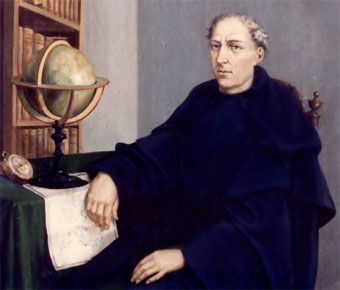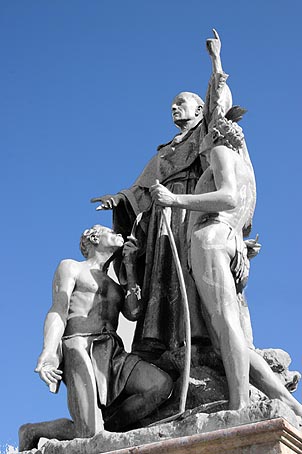<Back to Index>
- Explorer Andrés de Urdaneta, 1498
- Writer Jonathan Swift, 1667
- Field Marshal of the Luftwaffe Albert Kesselring, 1885
PAGE SPONSOR


Andrés de Urdaneta (Ordizia, Spain, November 30, 1498 – June 3, 1568, Mexico City) was a circumnavigator, explorer and Augustinian friar. As a navigator he achieved in 1528 the second world circumnavigation after the first one led by Ferdinand Magellan and Juan Sebastián Elcano in 1522. Urdaneta discovered and plotted a path across the Pacific from the Philippines to Acapulco in the Viceroyalty of New Spain (present day Mexico), which came to be known as "Urdaneta's route."
Urdaneta was born in the town of Ordizia in the Basque province of Guipúzcoa, Spain. Urdaneta was one of the few survivors of Loaísa Expedition to reach the Spice Islands, just to be taken prisoner by the Portuguese, but eventually he managed to return to Europe in 1528, achieving the second world circumnavigation in history after an expedition which lasted nine years. King Charles I of Spain did not give him a very favourable reception either, and, wearied by his many adventures, he went to New Spain and entered the Augustinian Order.
At the death of the viceroy Don Luís de Velasco, in 1564, New Spain had passed under the government of the Audiencia, one of whose first cares was to equip an expedition for the conquest and colonization of the Philippines. This had been ordered by Philip II in 1559. Fray Andrés de Urdaneta having been designated as the commander and the viceroy had the matter under consideration at the time of his death. Urdaneta was considered a great navigator and especially fitted for cruising in Indian waters. Philip II wrote urging him to join the expedition and offering him the command. Urdaneta agreed to accompany the expedition but refused to take command; the adelantado, Don Miguel López de Legaspi, was appointed commander. The expedition, composed of the Capitana, which carried on board Legazpi and Urdaneta, the galleons San Pablo and San Pedro, and the tenders San Juan and San Lucas, set sail on November 21, 1564.
After spending some time in the islands, Legazpi determined to remain and sent Urdaneta back for the purpose of finding a better return route and to obtain help from New Spain for the Philippine colony. Urdaneta set sail from San Miguel on the island of Cebu, on June 1, 1565 and was obliged to sail as far as 36 degrees North latitude to obtain favourable winds. With the voyage in trouble, Urdaneta had to assume command in person. The ship reached the port of Acapulco, on October 8, 1565, having traveled 12,000 miles (20,000 km) in 130 days. Fourteen of his crew died; only Urdaneta and Felipe de Salcedo, nephew of López de Legazpi, had strength enough to cast the anchors.
Upon arriving, he discovered that a member of the crew of his expedition, Alonso de Arellano, who had abandoned them just after leaving the port, had actually beaten them across the ocean, arriving at Barra de Navidad in Jalisco in
August of the same year. However, Arellano's notes were far less
precise and professional than Urdaneta's, and so the latter's route
became the famous and trusted one. From
Mexico, Urdaneta went to Europe to make a report on the expedition and
returned to New Spain, intending to continue on to the Philippines, but
he was dissuaded by his friends. He wrote two accounts of his voyages:
one giving the account of the Loaiza expedition was published; the
other, which gives the account of his return voyage, is preserved in
manuscript in the archives of the Indies. For the remainder of the 16th and 17th centuries, Spanish ships, particularly the annual Manila - Acapulco trading Galleon,
used "Urdaneta's route." For a variety of reasons, they never explored
much of the Pacific coast of North America, and not all the Pacific
Islands, although Spain kept nominal suzerainty over most of the
Pacific Ocean well into the 19th century. Urdaneta died in Mexico City, 1568.